Whether you are an experienced pilot or a student pilot, you must know how a windsock works. Don’t be surprised, it is eventually called a wind cone.
How Does A Windsock Look Like?
It’s a conical textile tube that resembles a giant sock. It can be used as a basic guide to wind direction and speed. The tube material is cut to form a taper when stitched together. It allows the wind sock to float in the air due to the pressure caused inside. In this way, the wind causes lift through the sock and makes it stick out.
Is It Real That A Windsock Is This Simple?
A windsock is not as simple as it seems to be. Its work involves some other additional parts. The first one is the sock hoop. That is a round metal wire stitched into the sock opening. It can be found right where the wind goes inside. The main function of the hoop is to keep the sock open to let the wind blow through. The other additional part is the swivel that is attached to the hoop and mounted on the pole. When the wind changes direction, it allows the sock to swing around and open into the wind.
Why Is It Shaped Like A Cone?
Having a large opening and smaller exit gives the wind sock all the features it needs to act like a funnel for wind. The aerodynamics of a windsock involve compression. The compression is very small but is enough to force the sock up and out. As the tube gets smaller, the pressure and speed of the wind get higher. Due to that, the wall of the sock gets pushed out which makes it stick straight out. This process may cause some turbulence inside the sock that makes it flutter.
Are Windsocks Being Used At Night?
Did you know, that at many airports, windsocks are lit at night? It is done with the help of floodlights on top surrounding the cone or with one mounted on the pole shining inside it.
What Do The Different Stripes Mean?
Finally, in the picture below you can see the meaning of the different stripes and colors of the wind cone:

Hope you enriched your aviation knowledge with useful information while reading this article.
Have A Safe Flight!
Team FlyGo-Aviation

